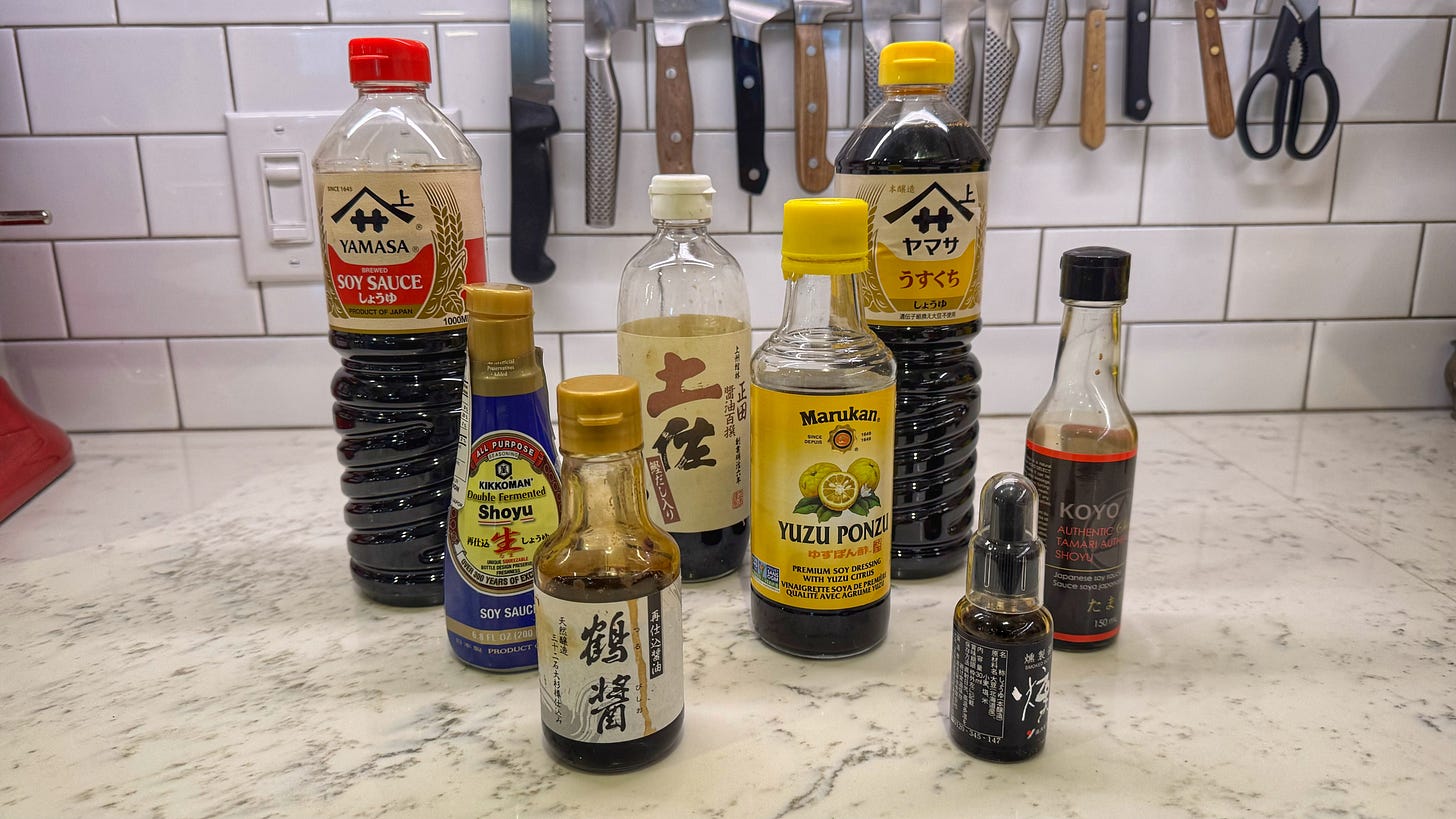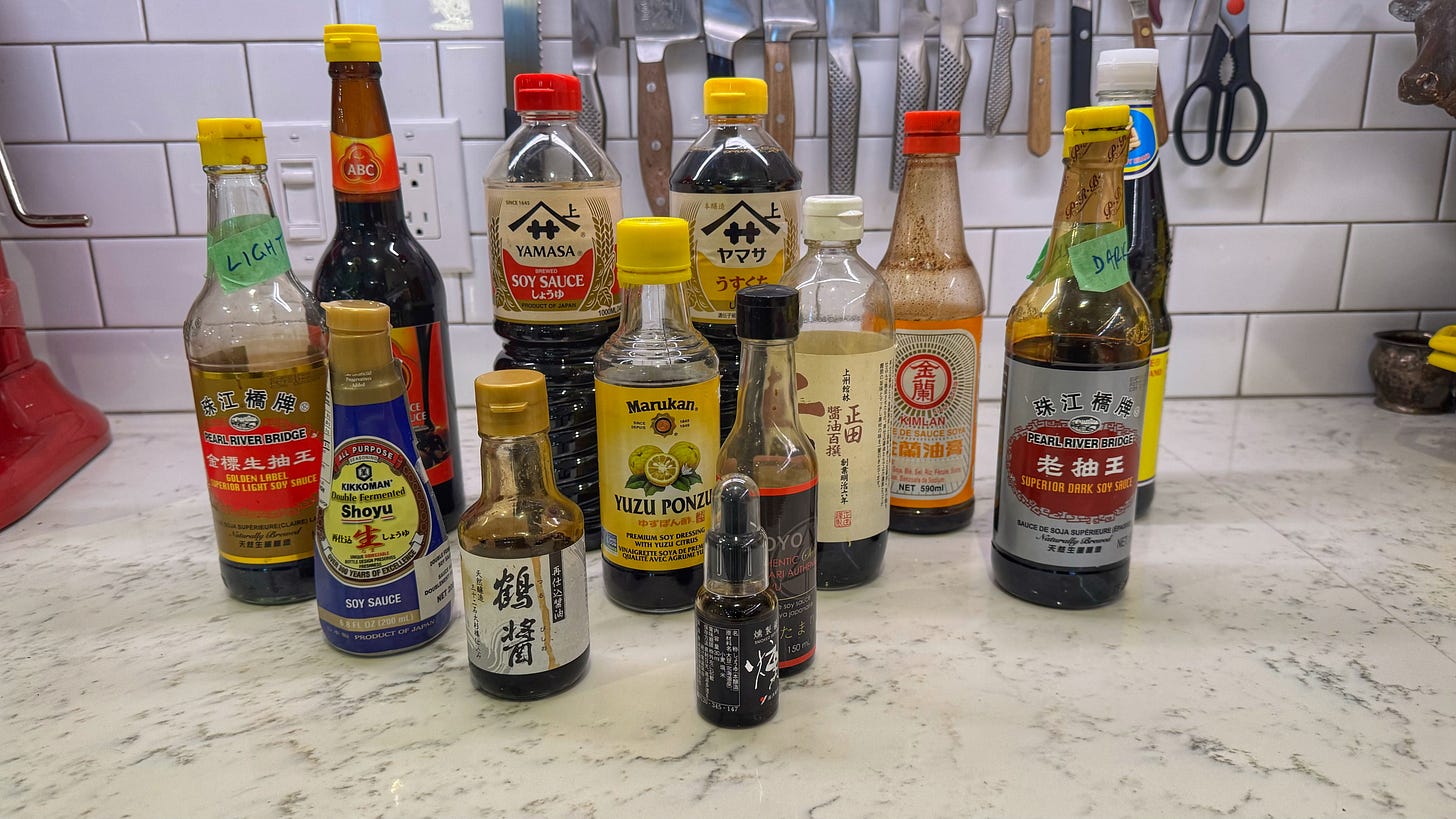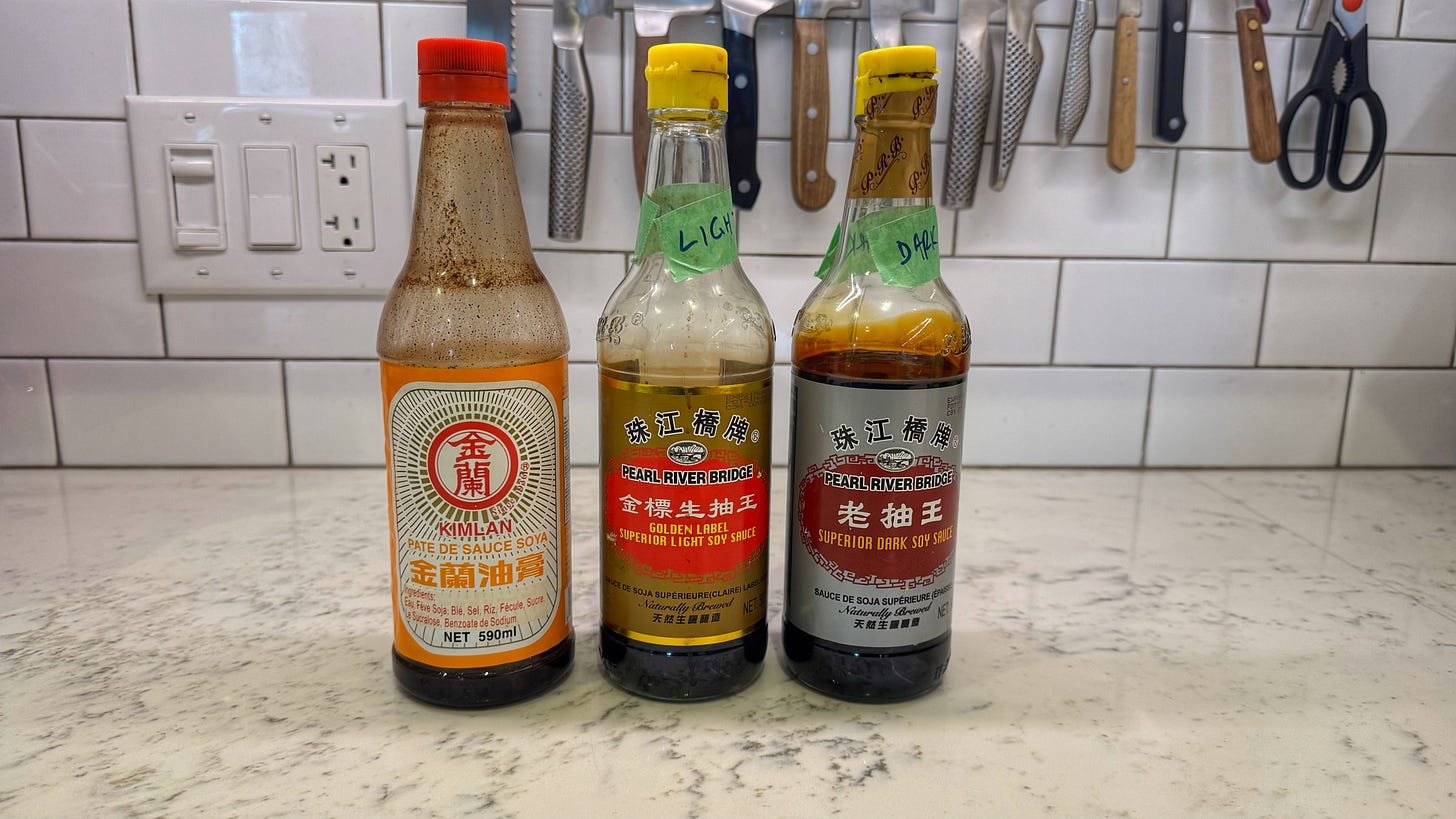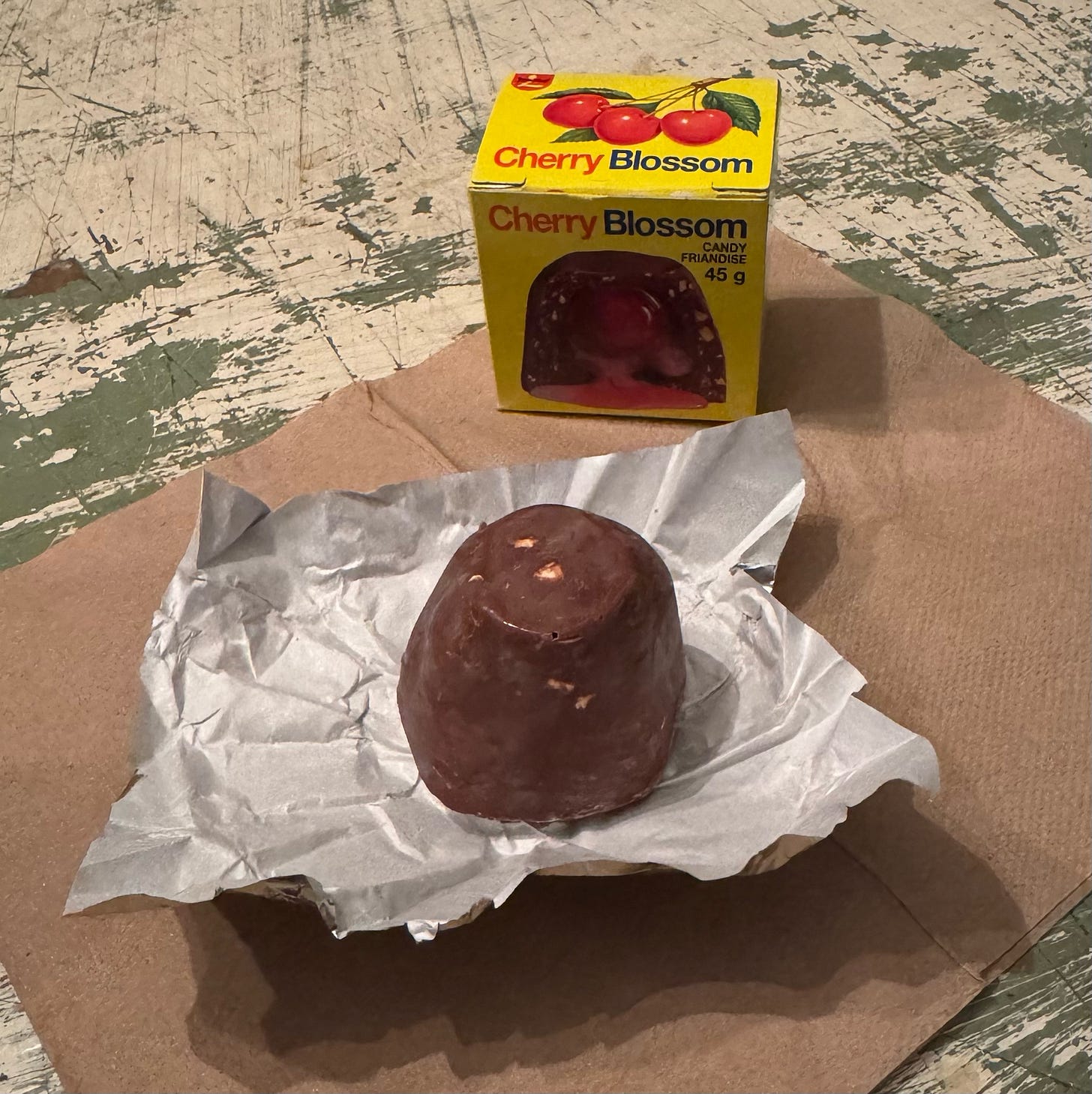58. Keep the change
Leaving behind something you've used for your entire life
I’m sure there are things that you do in your life, and methods you use, that you haven’t ever questioned or stopped to consider. Maybe it’s the order in which you do your morning bathroom stuff. (Do you brush your teeth before or after you shower?) Or where you keep your hot sauce. (The fridge? The cupboard?) One thing that I never stopped to think about is shoyu, Japanese soy sauce. More specifically, the brand of shoyu.
My whole life I’ve lived in a Kikkoman house. It’s what we used when I was a kid. It’s what I bought when I went to university. It’s what I bought when I lived in Japan and, I’m guessing, there were a lot more choices available. When it ran out, it never entered my mind to buy a different brand.
Recently, as I poured the last of my large container of Kikkoman into the smaller, iconic red-capped dispenser, I remembered an Epicurious article I had read about which soy sauces different chefs use. In it, Niki Nakayama, chef-owner of L.A.’s Michelin-starred n/naka, says that her restaurant uses Yamasa.
I thought to myself that maybe it was time to give something else a try. Then another thought quickly entered my head: “What was I thinking? We’re Kikkoman people. We can’t walk away from that.” The utter disbelief that I would even consider switching shoyu brands was not unlike the reaction I would get if I momentarily considered gargling with Clorox. It was absolutely unthinkable.
Or was it?
There’s something to be said about sticking with things. Not chasing after something that might possibly be better. Of what is called satisficing. But as I once described myself when writing about a crack in our cutting board, I am an optimizer, not a satisficer. Not knowing if Yamasa was better than Kikkoman would kill me. I had to know. So I went out and bought a large bottle of Yamasa to have on hand right when the last of the Kikkoman left the dispenser. I finally used up the last of it while I was making chow mein last week. So I poured the last few dregs from the dispenser into a shallow dish and then did the same with the newly opened Yamasa. The difference was immediately apparent.
The Yamasa was much lighter and clearer, while the Kikkoman was dark and almost inky. The difference in taste was also immediately apparent. The Yamasa was smooth and more subtle. It was salty, of course, but nowhere near as intensely salty as the Kikkoman. Tasted after the Yamasa, the Kikkoman seemed one-dimensional and spiky, if that can be used to describe a flavour.
I did not regret having used an inferior shoyu since the Nixon administration, but I was glad to have finally learned there was something better out there. This is a Yamasa house from now on (until some chef with more Michelin stars tells me otherwise).
This brief taste test raised two new questions for me:
How many different types of soy sauce do I have?
Why haven’t I tasted them straight and side-by-side before?
The answer to the first question is 13. The answer to the second question is that I now have. The executive summary is this: they are all salty and brown. But there are some differences between them. Let’s look at them in groups.
The Japanese

Koikuchi — This is what could be called the default shoyu. If you’re buying shoyu and it doesn’t say anything else, it’s koikuchi. It’s fairly dark and in the case of the Yamasa, smooth and somewhat complex.
Usukuchi — Thinner and saltier than koikuchi, it’s often used when the goal is to add saltiness without affecting the dish’s appearance as much.
Double fermented — This is a premium koikuchi that, much like a double chicken stock in which the usual stock ingredients are simmered in chicken stock instead of water, uses shoyu for the second fermentation instead of salt water. This is supposed to double the umami and savouriness. Its flavour profile is pretty similar to regular Kikkoman koikuchi, but it definitely has a bit more character and less spikiness.
Yamaroku Tsuru-bishio — Another premium koikuchi that is aged for 1-2 years, then fortified with additional soy beans and wheat, and then aged for another 2-3 years. This is great stuff. And at $15 for a tiny bottle reserved for special occasions.1
Tosa Joyu — This is shoyu that has been simmered with sake and katsuobushi (flakes of simmered, smoked, and fermented bonito) to give it a slightly smoky flavour. It’s mainly used for dipping sashimi, but when used in place of koikuchi, it adds an added dimension to dishes. It’s also one of the most pleasant to taste straight out of the bottle. (Editor’s note: Mike introduced me to this and I use it for pretty much everything.)
Ponzu — Koikuchi that has been simmered with citrus, kombu, mirin, and katsuobushi to give it a bright, tart flavour. It’s often used for dipping tataki (lightly grilled slices of bonito or steak) or the ingredients from nabe (hotpots) like shabu-shabu.
Yuasa Smoked Shoyu — This tastes a lot like tosa joyu. A little goes a long way, much like the Yamaroku. It’s also around $15 and the bottle is even tinier.2
Tamari — Shoyu is traditionally made using soy beans and wheat. Tamari uses just soy beans, so it’s gluten free. I don’t normally have it, but a recipe I was making called for it. It’s very similar to koikuchi.
The Chinese
Soy Paste — Unique to Taiwan, soy paste is thicker than regular soy sauces. Many people liken its flavour to oyster sauce without the oyster and, thinned with a little water, it makes a good oyster sauce substitute as a condiment for Chinese greens like gai lan or bok choy. To me, the flavour is similar to koikuchi shoyu.
Light Soy Sauce — The most commonly used soy sauce in Chinese cooking. “Light” is just to distinguish it from dark soy sauce. It is much more fragrant than shoyu. The bottle I have almost tastes a little fishy, although there is no fish in it. Recipes often say you can use koikuchi shoyu and light soy sauce interchangeably, but it really does pack a bigger punch.
Dark Soy Sauce — Speaking of packing a punch, dark soy sauce is a wallop of flavour. Intensely dark in colour and taste, it’s sweet with a hint of licorice but not particularly salty. It’s usually used sparingly to avoid making dishes overly dark.
The Southeast Asians
Sweet Soy Sauce — Also called Kecap Manis, it’s viscous and sweet. This Indonesian sauce has a strong caramel-molasses flavour. I cannot figure out what recipe I bought this for.
Thin Soy Sauce — This translucent, medium-brown sauce from Thailand is very similar in flavour to shoyu. According to Hot Thai Kitchen, it’s the default soy sauce for Thai cooking. I had to unseal this bottle to taste it. I once drove around searching for thin soy sauce and couldn’t find it, so when I did find it once, I snapped it up but haven’t used it yet.
According to this guide to soy sauces, my collection is still missing a few types. I have no mushroom-flavoured soy sauce, for example. Perhaps one day I’ll have a need for it but until then I think 13 will tide me over.
How many kinds of soy sauce do you have in your cupboard?3 Let me know in the comments!
What I’m Consuming…
A Field Guide to Fermentation by Arielle Johnson and Lars Williams — I happened upon this book, self-published by the Danish restaurant Noma, while thrifting last week. Published in 2016, it’s a shorter, sparer precursor to The Noma Guide to Fermentation by David Zilber and Rene Redzepi published a couple of years later. Each chapter has a handy troubleshooting section that can help you figure out why your ferment went awry, which happens. What’s really wild about this book is that I can find almost no information online about it beyond free downloads of the PDF. There isn’t a single used copy available on Abebooks or Thriftbooks. About the only mention of it I can find is in a Toronto Life profile of the chef at Chantecler, which calls it a rare find. Not bad for $1.99! I had plans to make miso a few years ago but never acted on them. Maybe this is a sign to get back to it.
What’s on the Menu…
Like seemingly every other Canadian I follow on social media, upon hearing that Cherry Blossoms had been discontinued by Hershey, I rushed out to get one last taste. Or rather, one first taste, since I’d never actually had one before. Canonically, I don’t like cherries so I avoid any that aren’t in a Manhattan. But I do like cherry candies, so I figured I’d try one while I still had the chance.
And… I liked it! It was still pretty cold from the trip home from the store so the liquid in the centre wasn’t as flowing and messy as I’ve heard it can be. (It was still kind of messy.) The cold also muted the cherry flavour. What I enjoyed most was the Nut Milk Chocolate—milk chocolate with coconut and other nuts mixed in—that makes up the outer shell.
I learned about it from this post by Brian Sheppard (@themapletooth), a former executive creative director who has headed back to Newfoundland where he pursues his hobby (obsession?) with Canadian candy history, design, and culture. His instagram feed is an amazing trip through packaging you never expected to see again.
Who am I kidding? I constantly forget I have it so it very rarely gets used. It has aged another few years in the cupboard, so I should really try to remember it’s there.
And much like the Yamaroku, I also forget that I have it and have put a few years on it.
Or fridge? As I understand it, there’s no safety concern with keeping your soy sauces unrefrigerated, but it may cause them to change in flavour over time because of further fermentation at warmer temperatures.










i feel inadequate.. .I only have two and one is Kikkoman. The other is Chinese dark shoyu.